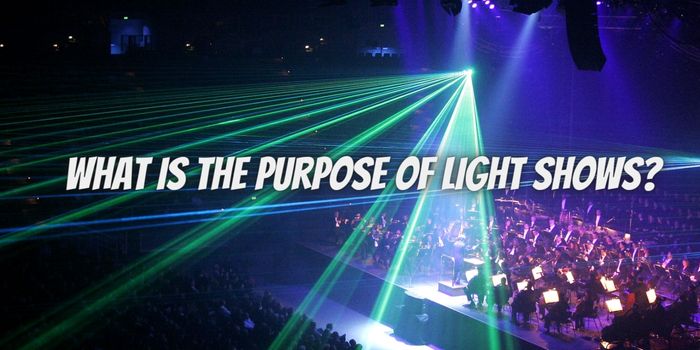Light shows have emerged as captivating spectacles in entertainment and visual artistry that engage and enthrall audiences across diverse settings. These vibrant displays of light, color, and movement are designed to evoke emotions, assemble immersive experiences, and enhance the atmosphere of events. From music concerts and festivals to architectural projections and theatrical performances, light shows have become integral components of modern entertainment. Delving into the purpose of light shows permits us to uncover their multifaceted roles and their profound impact on both individuals and the collective audience.
Uses of light shows
-
A Feast for the Senses
At the core of light shows’ purpose lies the intention to provide a multisensory feast for the audience. While traditional forms of entertainment focus predominantly on auditory and visual experiences, light shows add a dynamic layer that engages the visual sense in unprecedented ways. The interplay of colors, patterns, and movements synchronized with the music or other artistic elements creates an immersive sensory experience that captivates the audience’s attention. The convergence of light and sound triggers a synesthetic response, where the brain processes sensory information in a unified manner, leading to heightened emotional engagement and a more profound impact.
-
Enhancing Emotional Resonance
Light shows are masters at evoking emotions. The intentional use of different colors can evoke specific feelings and moods. For instance, warm colors like red and orange are associated with passion and excitement, while cool colors like blue and green evoke tranquility and serenity. By skillfully orchestrating color transitions and patterns, light shows can guide the audience’s emotional journey throughout the performance. This emotional resonance creates lasting memories, forging a strong connection between the audience and the event, artist, or brand.
-
Transforming Spaces and Narratives
One of the most remarkable aspects of light shows is their ability to transform spaces and narratives. Architectural projections, for instance, can pivot static buildings into dynamic canvases, enabling artists to tell stories and convey messages through light and motion. This transformational power permits the exploration of diverse themes and concepts, turning ordinary environments into captivating visual narratives. In theatrical performances, light shows play a pivotal role in setting the mood, shifting between scenes, and accentuating key moments, thus enhancing the overall storytelling experience.
-
Unleashing Creative Expression
For artists and designers, light shows serve as a canvas for boundless creativity and innovation. The ever-evolving technology behind light shows encourages the exploration of new techniques, such as 3D mapping, holography, and interactive lighting. These innovations empower artists to experiment with unique visual effects and push the boundaries of artistic expression. The fusion of technology and artistry in light shows opens up new realms of possibility, encouraging artists to translate their imaginative visions into tangible experiences that resonate with audiences on a profound level.
-
Fostering Unity and Shared Experiences
Light shows can foster unity and create shared experiences among diverse audiences. Attendees at music festivals, for instance, often locate themselves immersed in a collective experience where they share in the awe and wonder elicited by the dazzling display of lights. These communal moments transcend individual differences and create a sense of belonging, reinforcing the idea that people are part of something larger than themselves. Light shows, by virtue of their ability to captivate and engage groups of people, contribute to building a sense of community and connection.
-
Impacting Brand Identity
Beyond the realm of entertainment, light shows have also become a potent tool for shaping brand identities and departing lasting impressions on consumers. Companies continually incorporate light shows into product launches, marketing campaigns, and public events to convey their brand’s values, personality, and innovation. The visual impact of a well-executed light show can be etched into the minds of consumers, associating the brand with the positive emotions and excitement experienced during the event. This strategic usage of light shows underscores their power as a branding and communication tool in the modern business landscape.
-
Challenges and Ethical Considerations
While light shows are undeniably captivating and transformative, they also raise certain challenges and ethical considerations. Excessive energy consumption, light pollution, and potential negative environmental impacts are critical concerns associated with large-scale light displays. Striking a balance between artistic expression and environmental responsibility is a challenge that artists, event organizers, and designers must navigate. Moreover, the potential for sensory overload and the exclusion of individuals with certain sensitivities are factors that must be carefully considered to ensure that light shows remain inclusive and accessible to all.
The purpose of light shows extends far beyond their aesthetic appeal; they are dynamic tools for engaging emotions, telling stories, and creating immersive experiences. With the ability to transcend boundaries, evoke emotions, and foster connections, light shows have become essential components of contemporary entertainment, art, and branding. As technology advances and creativity flourishes, the role and impact of light shows will likely evolve, offering new ways to engage and delight audiences while posing fresh challenges that demand innovative solutions. In an age where human experiences are increasingly digitized, light shows are a testament to the enduring power of sensory engagement and artistic expression. Professional companies such as scotteffx.com provide light shows that can transform ordinary events into captivating and immersive experiences that leave a lasting impression on the audience.
